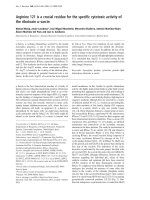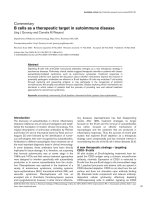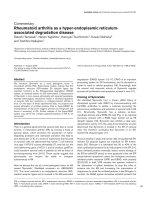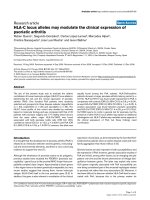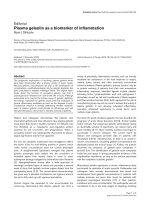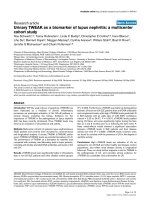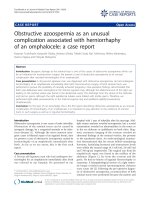Báo cáo y học: "Protein C as a surrogate end-point for clinical trials of sepsis" docx
Bạn đang xem bản rút gọn của tài liệu. Xem và tải ngay bản đầy đủ của tài liệu tại đây (40.59 KB, 2 trang )
Page 1 of 2
(page number not for citation purposes)
Available online />Abstract
Identification of good surrogate end-points can greatly facilitate the
design of clinical trials. Using data from PROWESS and
ENHANCE, Shorr and colleagues explore the potential value of
several plasma biomarkers for treatment trials of activated protein
C for severe sepsis. Based on the framework proposed by Vasan,
they tested the utility of several factors (protein C, interleukin-6,
antithrombin III, prothrombin time, protein S, and d-dimers) as type
0, 1 and 2 biomarkers. Only protein C had acceptable performance
characteristics as a type 2 biomarker, or surrogate end-point. The
utility of protein C as a surrogate end-point for studies of severe
sepsis must be validated in future prospective studies.
In this issue of Critical Care, Shorr and colleagues [1] tested
the potential value of surrogate markers for the treatment of
patients with severe sepsis with activated protein C, also
known as Drotrecogin alfa (activated; DrotAA), using data
from the PROWESS (Recombinant Human Activated Protein
C Worldwide Evaluation in Severe Sepsis) and ENHANCE
(Extended Evaluation of Recombinant Activated Protein C)
clinical trials. PROWESS [2] was a double-blind, randomized
clinical trial of DrotAA for the treatment of severe sepsis,
which identified a mortality benefit of treatment with DrotAA
in patients at a high risk for death. ENHANCE [3] was a
subsequent open-label trial of DrotAA in severe sepsis that
was designed to confirm the findings of PROWESS and to
provide additional data on drug safety.
Using a biomarker as a surrogate end-point in a clinical trial is
challenging but potentially innovative and valuable. Whereas
definitive phase III clinical trials that are based on mortality are
large and expensive, phase II clinical trials that are powered
to test differences in surrogate end-points can provide safety
and efficacy data that determine whether a large phase III trial
is indicated. In general, a biomarker can be considered to be
a reasonable surrogate end-point if changes in the biomarker
predict changes in a clinical end-point, such as death. Thus,
the degree to which a surrogate end-point is influenced by a
given therapy should correlate with the influence of that
treatment on the disease of interest.
However, caution must be used when considering surrogate
end-points [4]. In a classic example, although antiarrhythmic
drugs reduce cardiac arrhythmias, these agents were
subsequently associated with an increased rather than
decreased risk for death in CAST (Cardiac Arrhythmia
Suppression Trial) [5]. If the clinical outcome of interest is
influenced by several different factors in addition to the
surrogate end-point, then the surrogate marker may not be a
valid surrogate end-point. Consequently, Freedman and
colleagues [6] recommended that a valid surrogate end-point
should explain at least 50% of the impact that a therapy has
on the outcome of interest.
Because plasma protein C levels are low early in the course
of severe sepsis and then rise in those who recover and
survive, Shorr and colleagues [1] hypothesized that protein C
might be a good surrogate end-point (type 2 biomarker) for
treatment of sepsis with DrotAA. Because several other
biomarkers had been measured in these cohorts, those
investigators also explored the potential value of interleukin-6,
antithrombin III, prothrombin time, protein S, and d-dimers.
For this analysis, they used the conceptual framework for
biomarkers proposed by Vasan [7]. In this model, a type 0
biomarker is defined as ‘a marker of the natural history of the
disease and correlates longitudinally with known clinical
indices.’ The authors tested the association of these six
Commentary
Protein C as a surrogate end-point for clinical trials of sepsis
Kathleen D Liu
1
and Michael A Matthay
2
1
Divisions of Nephrology and Critical Care Medicine, Department of Medicine, University of California, 521 Parnassus Ave, C443, San Francisco,
CA 94143, USA
2
Departments of Anesthesia and Medicine and the Cardiovascular Research Institute, University of California, 505 Parnassus Ave, Moffitt Hospital,
Room M-917, San Francisco, CA 94143-0624, USA
Corresponding author: Michael A Matthay,
Published: 24 April 2008 Critical Care 2008, 12:139 (doi:10.1186/cc6859)
This article is online at />© 2008 BioMed Central Ltd
See related research by Shorr et al., />DrotAA = Drotrecogin alfa (activated); ENHANCE = Extended Evaluation of Recombinant Activated Protein C; PROWESS = Recombinant Human
Activated Protein C Worldwide Evaluation in Severe Sepsis.
Page 2 of 2
(page number not for citation purposes)
Critical Care Vol 12 No 2 Liu and Matthay
biomarkers with 28-day mortality and selected cut-offs for
biomarker levels based on sensitivity and specificity analyses.
However, even at the optimum cut-off, baseline levels of all six
biomarkers, including protein C, exhibited poor discriminant
function for death, with areas under the receiver operator
characteristic curve ranging from 55% to 60%.
The authors next examined whether any of these biomarkers
could identify a subgroup of patients in whom a greater
treatment benefit was observed. The cohort was divided into
groups with a higher and lower risk for death, based on the
baseline biomarker cut-off levels. The relative risk for death
was compared in those treated with DrotAA in each of these
two risk groups. Of the biomarkers studied, the only signifi-
cant difference was in the protein C group. In patients with
lower baseline plasma protein C levels (who were at greater
risk for death), treatment with DrotAA resulted in a statistically
significant reduction in risk for death.
Finally, to test whether these biomarkers could serve as a
potential surrogate end-point by predicting clinical benefit,
the authors found that 57% of the DrotAA effect was
explained by the change in protein C levels. The authors also
demonstrated that in DrotAA-treated patients, a higher
proportion of individuals had normal protein C levels (>80%
of normal) at the end of the drug infusion compared with
control individuals, and that survival in those with normal
protein C levels was higher in those patients treated with
activated protein C, as compared with control individuals. To
be a valid surrogate end-point, there should be some
plausible mechanism by which treatment influences the
surrogate end-point. The mechanism by which DrotAA
influences protein C levels is not entirely clear but may be
due to decreased consumption or increased hepatic produc-
tion of endogenous protein C; the proposed mechanisms
should be explored in future studies.
Based on the data and analysis presented in the report by
Shorr and colleagues [1], what is the potential value of
protein C as a surrogate end-point for treatment trials using
DrotAA? The authors propose several potential but untested
benefits, including identification of patients with severe
sepsis who are most likely to benefit from treatment with
DrotAA as well as to monitor patient response to therapy. The
use of protein C as a surrogate end-point may allow tailoring
of infusion length or drug dose to an individual patient; rather
than treating patients with a fixed dose of DrotAA for a fixed
period of time, it might be possible to tailor the infusion to
normalize protein C levels by 96 hours. Indeed, the
RESPOND (Research Evaluating Serial PC Levels in Severe
Sepsis Patients on DrotAA) study [8] is examining the safety
of higher doses of DrotAA (up to 48 μg/kg per hour) and
longer infusion times (up to 7 days), and the efficacy of these
infusions for normalization of protein C levels. We agree that
these are clinical scenarios in which protein C may have value
as a surrogate end-point. However, the true test of protein C
as a surrogate end-point will depend on demonstrating that
normalization of plasma protein C levels by DrotAA correlates
with patient benefit in future studies, including the
PROWESS-SHOCK trial [9].
Competing interests
The authors declare that they have no competing interests.
References
1. Shorr A, Nelson DR, Wyncoll D, Reinhart K, Brunkhorst F, Vail G,
Janes J: Protein C: A potential biomarker in severe sepsis and
a possible tool for monitoring treatment with Drotrecogin alfa
(activated). Critical Care 2008, 12:R45.
2. Bernard GR, Vincent JL, Laterre PF, LaRosa SP, Dhainaut JF,
Lopez-Rodriguez A, Steingrub JS, Garber GE, Helterbrand JD, Ely
EW, Fisher CJ Jr; Recombinant human protein C Worldwide Eval-
uation in Severe Sepsis (PROWESS) study group: Efficacy and
safety of recombinant human activated protein C for severe
sepsis. N Engl J Med 2001, 344:699-709.
3. Vincent JL, Bernard GR, Beale R, Doig C, Putensen C, Dhainaut
JF, Artigas A, Fumagalli R, Macias W, Wright T, Wong K, Sundin
DP, Turlo MA, Janes J: Drotrecogin alfa (activated) treatment in
severe sepsis from the global open-label trial ENHANCE:
further evidence for survival and safety and implications for
early treatment. Crit Care Med 2005, 33:2266-2277.
4. Fleming TR, DeMets DL: Surrogate end points in clinical trials:
are we being misled? Ann Intern Med 1996, 125:605-613.
5. The Cardiac Arrhythmia Suppression Trial (CAST) Investigators:
Preliminary report: effect of encainide and flecainide on mor-
tality in a randomized trial of arrhythmia suppression after
myocardial infarction. N Engl J Med 1989, 321:406-412.
6. Freedman LS, Graubard BI, Schatzkin A: Statistical validation of
intermediate endpoints for chronic diseases. Stat Med 1992,
11:167-178.
7. Vasan RS: Biomarkers of cardiovascular disease: molecular
basis and practical considerations. Circulation 2006, 113:
2335-2362.
8. Vangerow B, Shorr AF, Wyncoll D, Janes J, Nelson DR, Reinhart
K: The protein C pathway: implications for the design of the
RESPOND study. Crit Care 2007, 11(suppl 5):S4.
9. Barie PS: ‘All in’ for a huge pot: the PROWESS-SHOCK trial for
refractory septic shock. Surg Infect (Larchmt) 2007, 8:491-494.


